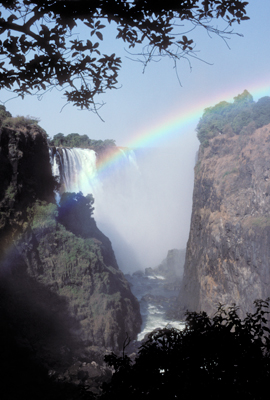 The elusive, ephemeral nature of rainbows is perhaps what attracts us to them. They may herald the return of sunshine after a storm, or be seen arcing through the mist above waterfalls, but they always lift our spirits. We feel we have been treated by nature to something rather special, and of course we have.
The elusive, ephemeral nature of rainbows is perhaps what attracts us to them. They may herald the return of sunshine after a storm, or be seen arcing through the mist above waterfalls, but they always lift our spirits. We feel we have been treated by nature to something rather special, and of course we have.
Rainbows are caused when sunlight falls upon airborne droplets of water. Refraction and internal reflection deflect each wavelength by a slightly different angle, separating the incident light into magnificent arcs of the seven colours of the visible spectrum; red, orange, yellow, green, blue, indigo and violet. The most brilliant rainbows are of the primary type, those that result from light emerging from water droplets after a single internal reflection. Secondary rainbows are produced by multiple reflections. They are less intense and the sequence of coloured arcs is reversed. All rainbows are seen when facing away from the sun.
Photographing the rainbow phenomenon is not particularly difficult. Normal exposures can be used although slight underexposure saturates the colours. When working with an SLR, some photographers use a polarizing filter to intensify the colours, but this must be done carefully. An incorrectly positioned polarizer may remove the rainbow from the image.
The most important factor in a rainbow image is the composition of the landscape or other elements, and their arrangement relative to the rainbow. The fleeting nature of rainbows makes this difficult to plan but the chances of a successful image can be increased by visiting suitable locations during a storm. If you get a break in the cloud your dedication may be rewarded. Another approach is to visit locations such as large waterfalls and geysers where large volumes of mist are suspended in the air. View the scene with your back to the sun, and in the right conditions you may be lucky.






